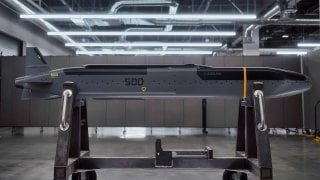New Barracuda Missiles: A Game-Changer in U.S. Air Military Strategy?
Anduril Industries has unveiled its new Barracuda family of cruise missiles, designed to address the U.S. military’s cruise missile shortage. With three variants—Barracuda-M 100, 250, and 500—the missiles offer advanced capabilities at lower costs, thanks to Anduril’s “hyper-scale production” approach.
These broadly-capable M-500s could be tasked with engaging warship communication systems, radar arrays, and other vulnerable systems, or to engage land-based command and control elements, armor, and more. Other Baracuda-500s could provide electronic warfare support, ISR (intelligence, surveillance, and reconnaissance) for follow-on strikes, or real-time battle-damage assessments as the fight plays out.
Combine this swarm of stand-off munitions with electronic warfare attacks mounted by carrier-based EA-18G Growlers carrying Next-Generation Jamming Pods, swarms of ADM-160 Miniature Air Launched Decoys broadcasting the radar returns of B-52 bombers and F-15e Strike Eagles, and waved of stealthily F-35Cs launched from carriers and B-21 Raiders closing with Chinese shores from across the globe, and you have the recipe for a chaotic environment full of real and imagined threats that would rapidly saturate and overwhelm even the most advanced and capable integrated air defense system China’s yuan could buy.
By supplementing the JASSM family of weapons with Barracudas, America’s high-end cruise missile stockpiles would last longer, making it more feasible to replenish stores with strategically viable timelines, with rapidly expanding Barracuda production lines providing a steady supply of stand-off weapons that may not pack the power to engage hardened targets, but offer more than enough to wreak havoc on surface-based command and control assets, enemy armor, and more.
Put simply, the Barracuda-500 could be thought of as a JASSM-junior: It’s not as capable, but at the same time, it’s not as expensive and can be deployed in much greater volume, providing Uncle Sam with the high-low mix of standoff munitions it would need to keep fighting for as long as it took to secure victory.
Or… at least that’s Anduril’s plan. While the firm does say that test articles of all three Barracuda variants are already flying, these weapons are still very much theoretical. Whether or not they move into production and operational service is a question the Pentagon will likely address in the months or years ahead, and until the program begins to mature toward such a contract, this is all little more than a hypothetical thought exercise.
But admittedly, it’s one with a great deal of promise. As for whether or not Anduril can deliver on that promise. You can rest assured that we’ll be watching closely.
About the Author
Alex Hollings is the editor of the Sandboxx blog and a former U.S. Marine that writes about defense policy and technology. He lives with his wife and daughter in Georgia. This first appeared in SandBoxx.
Image Credit: Industry Handout.


